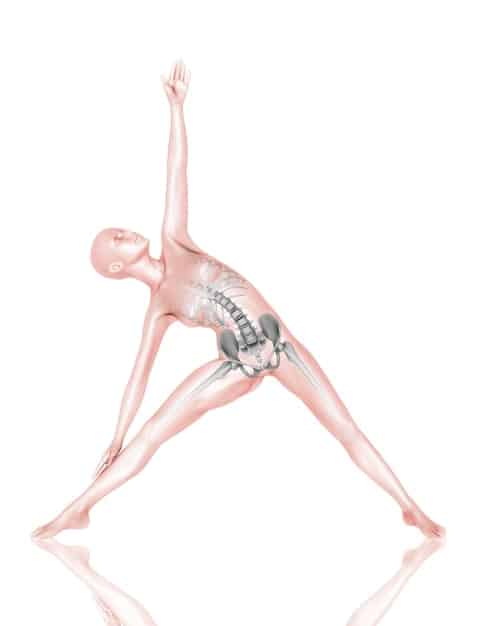Avoid Yoga Injuries: Expert Tips for Safe Alignment in 2025

Avoid These 5 Common Yoga Injuries: Expert Tips for Safe Alignment in 2025 provides essential guidance on preventing injuries during yoga practice, focusing on maintaining proper alignment and technique to ensure a safe and beneficial experience.
Yoga offers incredible benefits for physical and mental well-being, but improper form can lead to injuries. Avoid These 5 Common Yoga Injuries: Expert Tips for Safe Alignment in 2025, ensuring a safer and more rewarding practice.
Understanding the Risks: Common Yoga Injuries
Yoga, while generally safe, does carry certain risks if practiced incorrectly. Understanding these risks is the first step in preventing injuries and ensuring a sustainable yoga journey. Knowing the potential pitfalls allows practitioners to approach their practice with mindfulness and caution.
Wrist Pain
Wrist pain is a frequent complaint among yoga practitioners, often due to poses that place excessive weight on the hands and wrists. Poses like plank, downward-facing dog, and chaturanga require significant wrist strength and flexibility.
Lower Back Strain
Lower back strain can result from improper alignment, overextension, or pushing too hard in forward folds and twists. The lumbar spine is particularly vulnerable when core muscles are not engaged to support the movements.

Here are some common yoga-related injuries:
- Wrist strains from weight-bearing poses.
- Hamstring tears from overstretching in forward folds.
- Lower back pain due to improper alignment in twists and backbends.
- Neck injuries from incorrect head and neck positioning.
Being aware of these common risks allows individuals to be more cautious and proactive in preventing them, ultimately leading to a safer and more beneficial yoga experience.
Safe Alignment Principles
Proper alignment is the cornerstone of a safe and effective yoga practice. Focusing on correct alignment not only prevents injuries but also enhances the benefits of each pose. Understanding and implementing these principles can transform your practice.
Engaging Core Muscles
Engaging the core muscles provides stability and support for the spine, which is crucial in many yoga poses. A strong core helps maintain proper alignment and reduces the risk of lower back strain.
Maintaining Neutral Spine
Maintaining a neutral spine means preserving the natural curves of the spine. It requires awareness of your body and the ability to adjust your posture to avoid rounding or arching the back excessively.

Key alignment principles include:
- Engaging core muscles to support the spine.
- Maintaining a neutral spine in poses.
- Distributing weight evenly in weight-bearing poses.
- Using props to support and modify poses.
By adhering to these alignment principles, you can minimize the risk of injury and deepen your understanding of each pose, making your yoga practice more fulfilling and safe.
Expert Tips to Avoid Yoga Injuries in 2025
To avoid injuries, it’s essential to incorporate expert tips into your daily yoga practice. These tips ensure that you’re not just going through the motions but are truly engaging with your body in a safe and effective way. These recommendations are designed to enhance your body awareness.
Listen to Your Body
One of the most important things you can do to prevent yoga injuries is to listen to your body. Pay attention to any pain or discomfort and adjust your poses accordingly. Pushing through pain can lead to serious injuries.
Use Props
Props like blocks, straps, and blankets can be incredibly helpful in achieving proper alignment and modifying poses to suit your individual needs. Don’t hesitate to use them to support your body and deepen your practice safely.
Here are some specific tips to prevent common yoga injuries:
- Warm up properly before starting your practice.
- Engage your core muscles throughout each pose.
- Maintain proper alignment and avoid overextending.
- Use props like blocks and straps to support your body.
By incorporating these expert tips, you can create a safer and more sustainable yoga practice that supports your overall health and well-being, reducing the chances of injury in 2025.
Modifications and Variations for Injury Prevention
Everyone’s body is different, and what works for one person may not work for another. Understanding modifications and variations allows you to personalize your practice, making it safer and more accessible. By adjusting poses to fit your body’s unique needs, you can avoid injuries.
Modifying Poses
Learning how to modify poses is crucial for injury prevention. Start with simpler variations of poses and gradually progress to more challenging ones as your strength and flexibility improve.
Using Variations
Exploring variations of poses can also help you find what works best for your body. There are often multiple ways to approach a pose, and finding the right variation can make a big difference in preventing injuries.
Effective modifications and variations include:
- Using a wall for support in standing poses.
- Modifying weight-bearing poses to reduce wrist strain.
- Adjusting forward folds to protect the lower back.
- Exploring variations of twists to accommodate individual flexibility.
By understanding and utilizing modifications and variations, you can create a yoga practice that is tailored to your unique needs and abilities, minimizing the risk of injury and maximizing the benefits.
Warm-Up and Cool-Down Essentials
A comprehensive warm-up and cool-down routine is essential for preparing your body for yoga and aiding in recovery. These routines help to increase flexibility, reduce muscle tension, and prevent injuries. Neglecting these crucial components can increase the risk of strains and sprains.
Dynamic Stretching
Dynamic stretching involves active movements that warm up the muscles and increase range of motion. Examples include arm circles, leg swings, and torso twists.
Static Stretching
Static stretching involves holding a stretch for a period of time to lengthen the muscles. Examples include hamstring stretches, quad stretches, and calf stretches.
Essential elements of warm-up and cool-down routines include:
- Dynamic stretching to increase range of motion.
- Gentle cardio to warm up the muscles.
- Static stretching to lengthen and relax the muscles.
- Mindful breathing exercises to calm the nervous system.
By prioritizing warm-up and cool-down routines, you can enhance your yoga practice, improve flexibility, and significantly reduce the risk of injury.
| Key Points | Brief Description |
|---|---|
| 🧘♀️ Proper Alignment | Ensures safe and effective yoga practice, preventing injuries. |
| 👂 Listen to Your Body | Adjust poses according to your body’s signals to avoid strain. |
| 🧱 Use of Props | Supports alignment and modifies poses for individual needs. |
| 💪 Core Engagement | Stabilizes the spine and reduces the risk of lower back injuries. |
FAQ Section
▼
The most common yoga injuries include wrist strains, hamstring tears, lower back pain, and neck injuries. These often occur due to improper alignment or overexertion.
▼
To prevent wrist injuries, distribute weight evenly across your hands, engage your core, and modify poses by using your forearms or fists if needed. Regular wrist strengthening exercises can also help.
▼
Props like blocks, straps, and blankets help support proper alignment and modify poses to suit your body’s needs. Using props can reduce strain and prevent injuries, especially for beginners.
▼
Yes, warming up before yoga is crucial. It increases blood flow to muscles, improves flexibility, and prepares your body for the practice, reducing the risk of strains and sprains.
▼
Pay attention to your body’s signals. If you experience sharp, shooting, or persistent pain, you’re likely pushing too hard. Yoga should feel challenging but not painful.
Conclusion
By integrating these expert tips and safe alignment principles into your yoga practice, you can effectively avoid common yoga injuries and enjoy a more sustainable and beneficial experience. Remember to listen to your body, use props as needed, and modify poses to suit your individual needs. With mindful practice, you can reap the many rewards of yoga while minimizing the risk of injury, ensuring a fulfilling practice for years to come.





